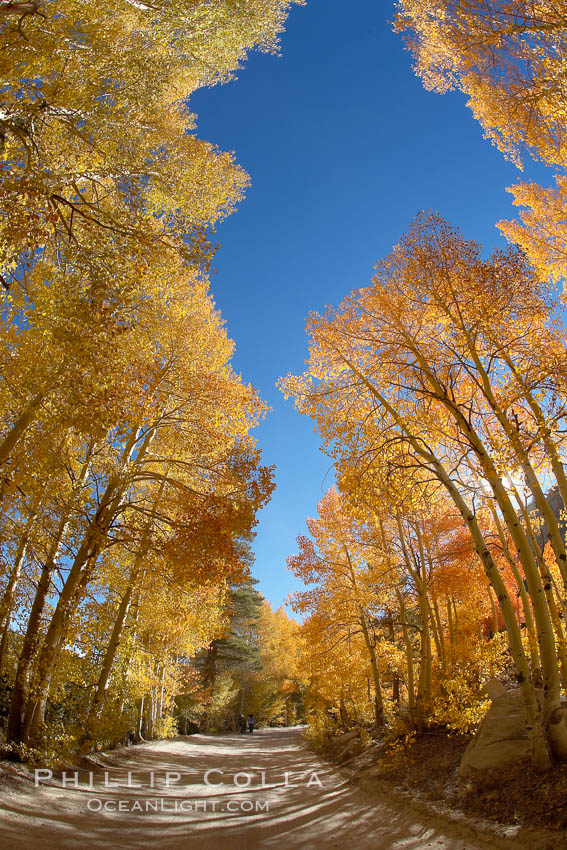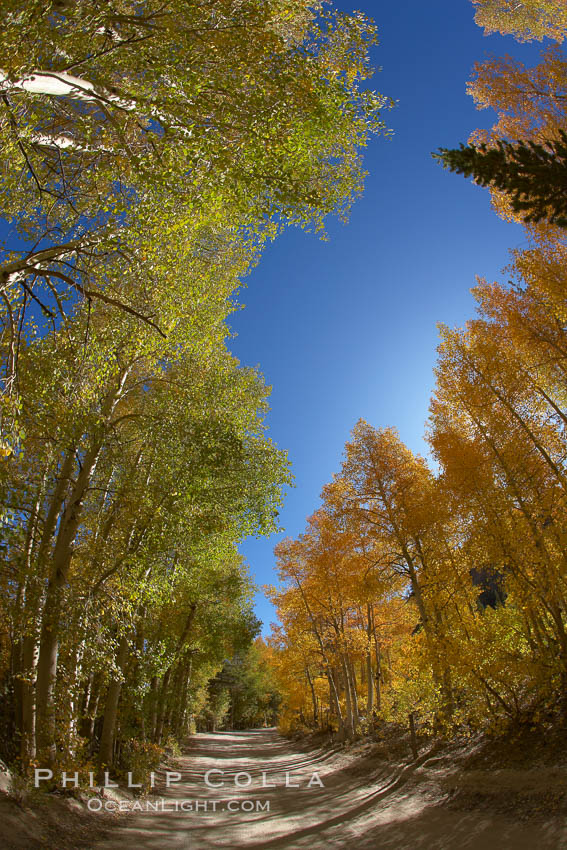Along the road that runs beside North Lake in the Bishop Creek watershed is a section I have heard referred to as the “Aspen Tunnel“, an apropos name certainly. Tall quaking aspen trees (Populus tremuloides) on either side lean over the road, creating a impressive cylinder of color. If you are looking for a spot where you can point your camera up and shoot that classic “aspen trees reaching for the sky” shot (here’s another example), this is absolutely the easiest place I have found to do it. I first saw this spot in early October 2006 at which time the color in the leaves was rich and bright. I was there again most recently in late September 2009 when the trees on one side of the road were green while those on the other side were gold. This dichotomy of color is not all that curious: trees in a stand of aspens are typically clones of one another by virtue of their root system and reproduction mechanism; they tend to change color in unison.
Aspen trees displaying fall colors rise above a High Sierra road near North Lake, Bishop Creek Canyon.
Image ID: 17501
Species: Aspen, Populus tremuloides
Location: Bishop Creek Canyon, Sierra Nevada Mountains, California, USA
A tunnel of aspen trees, on a road alongside North Lake. The aspens on the left are still green, while those on the right are changing to their fall colors of yellow and orange. Why the difference?
Image ID: 23342
Species: Aspen, Populus tremuloides
Location: Bishop Creek Canyon, Sierra Nevada Mountains, California, USA
The aspen tunnel spot is best photographed when the sun has risen fairly high in the sky. Go ahead and shoot the sunrise at North Lake from the usual spot. Then go for a walk around the lake (it’s a short and flat walk!) and kill some time wandering through the grove on the northwest side of the lake as you do so. When other photographers have departed (“the light is too harsh”, “I don’t shoot during midday”), you can make your way over to the aspen tunnel and have it largely to yourself. If you choose your angles properly you will find that trees on both sides of the road are richly colored by the strong backlighting of the mid morning sun. A polarizing filter will drop the sky to a deep blue. Keep in mind, the wider your lens, the more of the color you can pack into your composition and the more accentuated the effect of the polarizer will be. I tend to use lenses such as a 15mm fisheye and 16-35mm superwide zoom in this spot in an attempt to find compositions in which the viewer feels immersed inside a grove of intense color and tall thin trees. (A 24mm lens, often considered “wide”, is definitely not wide enough here.) It is not a good idea to change lenses here, in fact you’ll see the dust from the dirt road hanging in the air all around you. When a car or horse trailer drives past I cover my lens and step off the road for a few minutes until the dust has cleared.
Keywords: aspen tunnel, quaking aspen, populus tremuloides, autumn.





